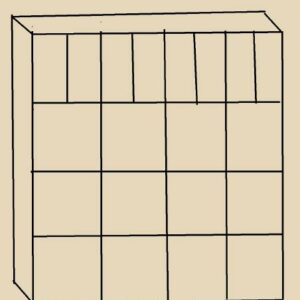I’m building a bookshelf with cubbies of a specific size (12w x 13h) for storing piano music. There will be four cubbies per shelf. Double that on the top shelf. See rough sketch. I’m planning to use 3/4″ red oak boards attached with screws. Being a rookie in the world of wood working, I have some basic questions
1. How do I drill the holes so that the screws are recessed? Is it as simple as using a large bit to be around 1/4″ deep, and then a smaller bit for the screws pilot hole?
2. What is the best way to cover up those screw holes when finished. I was planning to use some wood glue and flat oak plugs or dowels cut to fit. I thought that using filler even if it was stained, would not look as good.
3. Lastly, I can certainly screw one side of the cubbie dividers into the adjacent shelf, but how do I attach the cubbie divider that stands on the shelf directly above the lower cubbie divider? Do I just put some dowel pins into the divider and lower shelf? I am planning to attach some 1/2″ oak panels on the back side to help with stability.
Any Other Advice Would be Appreciated!!! Thank you!!!
















Replies
Using recessed screws with plugs is a common thing in woodworking, the small hole is the size of the OD of the screw and the larger hole is 3/8 inches, a stepped drill is the best way to do this quickly and accurately, otherwise you first drill the 3/8 hole halfway through the plank and then the smaller one. It gets covered by a 3/8 inch plug that you can make with a plug cutter or buy.
You can’t only use screws as the joining method, as you found, you would only be accessing one side of each divider. Normally we build a frame with shelves or uprights, your choice, and slide the dividers (or shelves) in a rabbet and glue them in place.
If you wish to use only screw joinery, then I’d consider 4 stand-alone cubbies and stack ‘em to match your drawing. Also cut square templates to lay flat on the inside tops and bottoms to align and square up the dividers. Thinner stock would also work for the tops and bottoms to keep better proportions.
Or, go the classic dado & rabbet route as Gulfstar mentioned.
Here are a couple additional ideas to consider:
Use pocket screws on the underside of the dividers. To do this, you will need to invest in an inexpensive guide and special bit to drill the pocket holes, such as the ones made by Kreg.
Set the shelves on ledger strips set back a bit from the front of the bookcase. Put a deeper front edge on each shelf to cover the ledgers and create the illusion of thicker shelves.
Thanks for all of the helpful advice. I appreciate it!
For your #1 question, you need to countersink the holes, for the cone-shaped wood screws to go below the surface. Either get bits with the cone-shaped cutter as part of the bit, or separate cone-shaped drill bits that just drill the hole. Countersink is the term to search on.